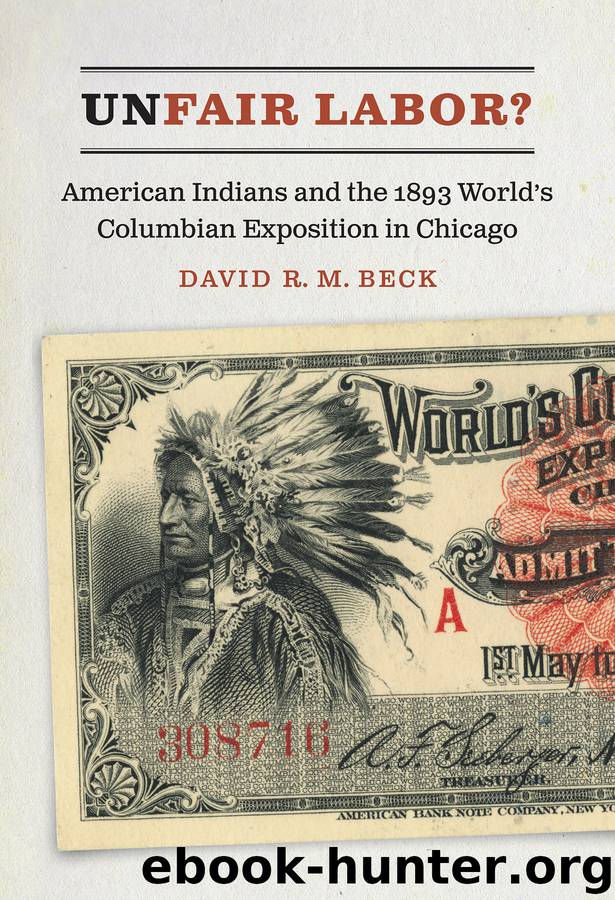Unfair Labor? by Beck David R. M.;

Author:Beck, David R. M.;
Language: eng
Format: epub
Tags: SOC021000 Social Science / Ethnic Studies / Native American Studies, BUS023000 Business & Economics / Economic History
Publisher: UNP - Nebraska
34. Rain-in-the-Face, Lakota. Courtesy Library of Congress. Photo number 3c04681u.
Native Hawaiians
Other indigenous peoples with relations to the United States also worked the Midway. Three groups of Native Hawaiians provided music in two venues at the fair. At least fifteen Native Hawaiians came from Honolulu to provide entertainment to fairgoers. The kingdom of Hawaii, in the years before the overthrow of Queen Lili‘uokalani, attempted to organize an exhibit. It was supported by both the Honolulu Chamber of Commerce and the Planters’ Labor and Supply Company. The latter had no interest in supporting “an exhibition of curios relating to ancient times [that] would mislead strangers, and give a wrong impression in regard to the present condition of Hawaiian civilization and affairs.”50
Political events overtook the islands as the queen was placed under house arrest and a provisional haole (white foreigner) government took over. However, Lorrin Thurston, who worked both at the queen’s behest and toward her overthrow, organized an exhibit which he referred to as both an artistic success and a business failure.51 He developed a cyclorama of the Kilauea Volcano on the Island of Hawaii that proved to be a popular Midway exhibit. It stood nearly 60 feet high and measured 140 feet in length, in a sixteen-sided building. As he described it, the paying customer stood in the center on a model of the crater floor. “At one side, there was a representation of a molten lake; on the other side, the floor of the crater appeared, with cracks from which steam was rising; at the bottom of the cracks, molten lava was simulated; and the walls of the main crater surrounded the whole.” It was electrically lit. The cyclorama, initially estimated to cost upwards of $25,000 to build and install, in the end cost more than $80,000.52 A small part of his expenses went to pay Hawaiian entertainers.
A group advertised as the late King David Kalākaua’s “favorite quartet,” which included the famed Nulhama “William” Aeko, performed outside the exhibit to draw attention and again inside during tours of the cyclorama. The singing group was also advertised as the Volcano Singers.53 In addition to this quartet, Thurston brought five more musicians to perform. One of them was Duke Kahanamoku, whose son would later become a renowned swimmer. A Chicago Tribune advertisement proclaimed, “Native singers from Hawaii singing their beautiful songs on the banks of the burning Lakes of Kilauea.”54 The members of the quartet each received $50 a month plus their round-trip fare from Honolulu to Chicago.55 They worked from 8 a.m. to 11 p.m.56
Download
This site does not store any files on its server. We only index and link to content provided by other sites. Please contact the content providers to delete copyright contents if any and email us, we'll remove relevant links or contents immediately.
| African-American Studies | Asian American Studies |
| Disabled | Ethnic Studies |
| Hispanic American Studies | LGBT |
| Minority Studies | Native American Studies |
Cecilia; Or, Memoirs of an Heiress — Volume 1 by Fanny Burney(32433)
Cecilia; Or, Memoirs of an Heiress — Volume 2 by Fanny Burney(31866)
Cecilia; Or, Memoirs of an Heiress — Volume 3 by Fanny Burney(31850)
The Great Music City by Andrea Baker(31319)
We're Going to Need More Wine by Gabrielle Union(18967)
All the Missing Girls by Megan Miranda(15560)
Pimp by Iceberg Slim(14376)
Bombshells: Glamour Girls of a Lifetime by Sullivan Steve(13971)
Talking to Strangers by Malcolm Gladwell(13219)
Norse Mythology by Gaiman Neil(13204)
Fifty Shades Freed by E L James(13157)
For the Love of Europe by Rick Steves(12917)
Mindhunter: Inside the FBI's Elite Serial Crime Unit by John E. Douglas & Mark Olshaker(9186)
Crazy Rich Asians by Kevin Kwan(9165)
The Lost Art of Listening by Michael P. Nichols(7403)
Enlightenment Now: The Case for Reason, Science, Humanism, and Progress by Steven Pinker(7227)
The Four Agreements by Don Miguel Ruiz(6618)
Bad Blood by John Carreyrou(6543)
Weapons of Math Destruction by Cathy O'Neil(6139)
